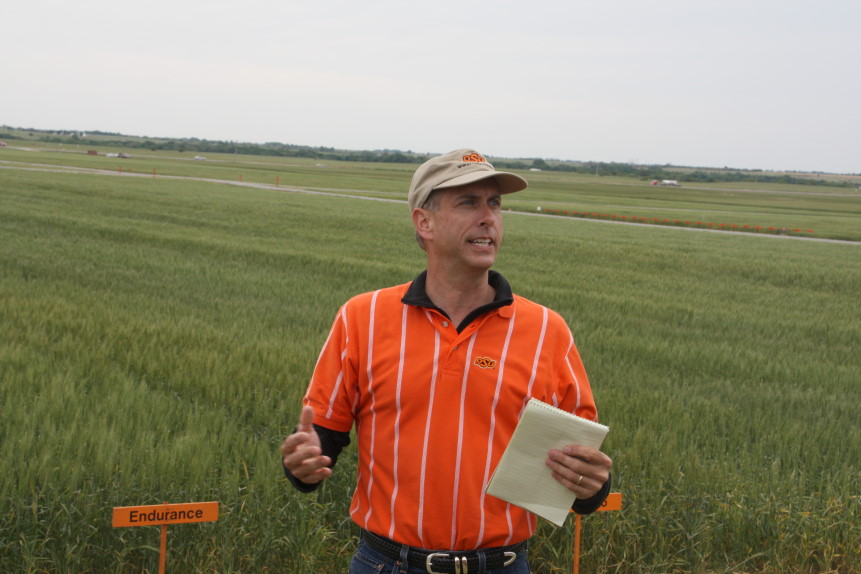
Agricultural News
OSU's Brett Carver on the State of His Wheat Breeding Program
Tue, 08 Jul 2014 18:14:47 CDT

As the reality of GMO wheat becomes more certain, more companies and land-grant universities have announced their efforts to work together in developing future wheat varieties. Oklahoma State University Wheat Breeding Specialist Dr. Brett Carver looks for the OSU program will remain independent.
"This breeding program is a public program and it is strongly supported by the public sector, that being our stakeholders, the farmers," Carver said. "The farmers out in our state who contribute to the check off and primarily that's where are research funding comes from."
"That checkoff has been a key part of our success," he said.
Carver also holds a faculty position that is endowed position that has been funded from the wheat producers of Oklahoma that was originated back in the late 80's. Carver says OSU also now has revenue coming in from seed sales, through Oklahoma Genetics Inc. He says all of these different streams make a strong program.
"I wouldn't say we run totally independently," Carver said. "We have to interact with other breeding programs because I strongly feel the success of this program is built on the success of others and I would to think that they think the same thing to."
"We do interact, we do in fact exchange experimental material, what we call germplasm, so we can keep the infusion of noval materials coming into the program," Carver said. "We also provide those programs with our own novelties that they can utilize and we hope this relationship continues."
OSU doesn't have as many of those exchanges with private companies as the university interacts readily with other public programs. Carver says OSU has created some agreement with various companies that with specific research projects. One example is project where OSU is working AgriPro/Syngenta in working on a double haploid project in creating a specific germplasm that will hopefully turn into a wheat variety. Carver says that new variety would hopefully have resistance to hessian fly, green bug, plus all of the other adaptation traits OSU is looking for.
OSU is also working with Pioneer in developing double haploid. Carver says OSU's germplasm is rich Pioneer bloodline from the 1980's.
"They can utilize our germplasm and we can also utilize their double haploid technology," Carver said . "Its a synergy I think that we need to take advantage of, but its not something we're going to have to depend upon on that relationship to survive."
In looking at the future of wheat varieties, Carver makes a point to illustrate double haploid technology is very different from GMO technology. Carver says you can use double
haploid in conjunction with GMOs and make significant progress.
"Double haploid technology allows us to turn this wheel a little faster," Carver said. "The wheel being how long does it take to go from a cross of two varieties to another variety that is derived from that cross."
On average it takes about 10 - 11 years to turn that wheel. Carver says if we can turn that wheel a little faster, progress and improvement can be made in a quicker time frame. Other technologies can contribute a little bit to turn that wheel faster with the use of molecular markers. He says using molecular markers are also getting more realistic in terms of cost.
In recent year's the OSU wheat breeding program has been able to put a focus on drought and drought resistance as a result of the recent climatic events. Carver says over the last three years we have had unbelievable opportunity to weed out the unfit germplasm that can't tolerate these dry conditions. Knowing these extremely dry conditions won't last forever, so they are working to keep their germplasm balanced in focusing on other aspects like maturity.
The OSU program has put a greater emphasis in controlling diseases like powdery mildew, strip rust and wheat streak mosaic. Carver says wheat streak mosaic has tended to more localized in the panhandle area, but they are now seeing that disease well into the body of the state. OSU has also put a lot resources in controlling tan spot, septoria, spot blotch. Additionally straw strenght is also a top priority. Carver says last year was an excellent opportunity to address straw strength and is we're going to produce 100 bushels per acre, they will have to put more emphasis on stability.
WebReadyTM Powered by WireReady® NSI
Top Agricultural News
More Headlines...



















